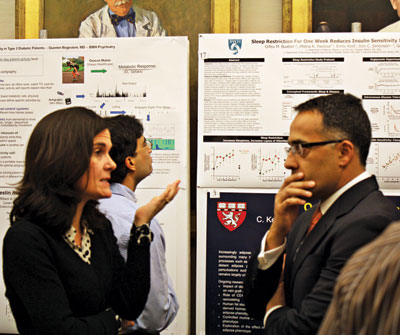Cardiovascular, Diabetes and Metabolic Disorders Research Center
This article is the first in a new series highlighting the 12 centers that comprise the Biomedical Research Institute (BRI) at BWH.

Emma Morton-Eggleston, MD, MPH, and Ali Tavakkolizadeh, MD, during February’s Obesity Incubator Session.
BWH consistently receives accolades for its specialties such as Cardiology and Endocrinology, ranking at the top of lists like U.S. News & World Report’s Honor Roll for America’s Best Hospitals. Without question, one of the reasons for the hospital’s high ranking is its collaborative research environment, which is thriving thanks to programs like the BRI’s Cardiovascular, Diabetes and Metabolic Disorders (CVDM) Research Center.
“The CVDM Research Center is a group of investigators all based at the Brigham that share a common interest in diseases related to the cardiovascular system,” said Andrew Lichtman, MD, PhD, of Pathology, who is one of three co-chairs of the CVDM Research Center. “It includes people who traditionally work with heart disease and blood vessel disease, and also those who work with diabetes and obesity. Ultimately, our goal is to promote collaborative interactions and progress and research in those areas.”
There are a number of projects and initiatives at the CVDM Research Center that make the center a leader in cardiovascular, diabetes and metabolic disorders research. Following is an overview of three of the center’s pillars.
‘Work in Progress’ Seminar Series
The CVDM Research Center holds a weekly “Work in Progress” seminar series in which trainees from laboratories present ongoing work with discussion from faculty. Each session’s topics are mixed, combining basic laboratory talks with discussions about translational or clinical investigation.
“We think of the seminar series as our ‘main street,’” said Lichtman, adding that many researchers in the community have said the series is one of the most helpful things the center does. “It gives people the opportunity to learn about what different labs in our research community are focusing on. People learn about other research that has common themes to their own, and they also have the opportunity to hear from people in the institution who are working on studies in the same area.”
Lichtman notes that one of the most successful features of the seminar series has been participation of clinicians in the conversation.
“Several times a year, we have clinicians talk about important unsolved problems in cardiovascular disease, so the researchers can get a broader feeling for the research needs that exist,” he said.
To see a list of upcoming seminar series topics, visit http://bwhbri.partners.org/bri_cardio
Obesity Incubator Session
In February, the CVDM Research Center hosted an incubator session on obesity research. The event was open to all BWH researchers and clinicians who are interested in coming together to exchange ideas and launch cross-collaborative research efforts in the field of obesity and obesity-related co-morbidities.
“It is similar to the seminar series in its intent to foster communication and collaboration among researchers, but the Obesity Incubator Session was designed to go one step further,” said Gail Kurr Adler, MD, PhD, of Endocrinology, who co-chairs the CVDM Research Center with Lichtman and Marc Pfeffer, MD, of the Cardiovascular Division. “Our goal was to identify the clinical problem of obesity and the clinical challenges and areas of needed research, and then to further promote communication.”
The second half of the two-hour program featured an interactive poster session on obesity-related research, focusing on early stage ideas and novel hypotheses.
“The idea of this seminar is to promote cross-collaboration,” Adler said. “So many of our clinical problems are overlapping, rather than the silos we once viewed them as. We want to get researchers out of these silos and talking to one another.”
Tissue Bank
Established in January 2010, the CVDM Cardiovascular Tissue Bank is a central resource facility for collecting, warehousing, cataloguing and distributing normal and specifically diagnosed cardiovascular tissue specimens. There are only three cardiovascular tissue banks in the country.
“We have a substantial body of cardiovascular researchers in our community. Cardiologists were often asking me if we had tissue samples for them, and it was distressing when we couldn’t provide them,” said Richard Mitchell, MD, PhD, of Pathology. “Surgeons generate a lot of material on a routine basis that we can add to our bank. And now, when cardiologists have a research idea, we will be able to provide them with a solid bank of tissues.”
As more and more disposed cardiovascular tissues are added to the bank, he says, it will become an invaluable resource for the community.
“It requires a certain amount of manpower and storage to bank away the tissue. We have to be able to preserve it in the ways people find useful; we also have to be able to identify and find it,” Mitchell said. “But, in the end, it will help BWH remain a leader in the diagnosis, prevention and treatment of cardiovascular and metabolic disorders.”